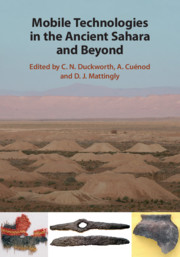Book contents
- Mobile Technologies in the Ancient Sahara and Beyond
- The Trans-Saharan Archaeology Series
- Mobile Technologies in the Ancient Sahara and Beyond
- Copyright page
- Contents
- Figures
- Tables
- Contributors
- Preface
- Part I Introduction
- Part II Technological Mobility and Transfers
- Part III Metallurgy
- Part IV Glass Technology
- 10 Shattering Illusions
- 11 Glass Beads in African Society
- 12 Three Millennia of Egyptian Glassmaking
- Part V Handmade Pottery
- Part VI Conclusion
- Index
- References
11 - Glass Beads in African Society
Beyond Chemistry and Provenience
from Part IV - Glass Technology
Published online by Cambridge University Press: 18 September 2020
- Mobile Technologies in the Ancient Sahara and Beyond
- The Trans-Saharan Archaeology Series
- Mobile Technologies in the Ancient Sahara and Beyond
- Copyright page
- Contents
- Figures
- Tables
- Contributors
- Preface
- Part I Introduction
- Part II Technological Mobility and Transfers
- Part III Metallurgy
- Part IV Glass Technology
- 10 Shattering Illusions
- 11 Glass Beads in African Society
- 12 Three Millennia of Egyptian Glassmaking
- Part V Handmade Pottery
- Part VI Conclusion
- Index
- References
Summary
The majority of archaeological analyses of glass beads focus on the provenance of the glass in order to reconstruct long-distance trade. This chapter, founded upon a review of anthropological literature, asks what else we might learn from studies of the production and consumption of these artefacts. A summary of the archaeology of the bead trade in the Sahara and the Sahel in the first and early second millennia AD is followed by a comparison of this trade with the trading and consumption of glass beads in southern Africa. One finding is that beads seem to have been more often reworked at Saharan and West African sites. This leads into a discussion of the sphere of bead production: its social and cultural contexts, the construction of technical traditions and the relationships between glassworking and other crafts. The sphere of consumption is then explored through a discussion of the myriad roles that glass beads play in many African societies, particularly in defining and negotiating identities, in economic transactions, as sources of power and in ‘fashion’. This is relevant to understanding what drives bead production and raises an important distinction between beads as goods subject to sumptuary laws and beads as trade items.
- Type
- Chapter
- Information
- Mobile Technologies in the Ancient Sahara and Beyond , pp. 385 - 422Publisher: Cambridge University PressPrint publication year: 2020
References
- 5
- Cited by

